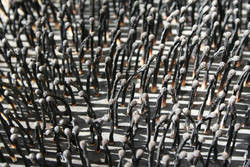Yerbossyn Meldibekov and Nurbossyn Oris
21 Jan - 21 Mar 2009
YERBOSSYN MELDIBEKOV AND NURBOSSYN ORIS
"Hallucination"
Opening: 21st of January 2009
The exhibition lasts until:
21st of March 2009
The works of the Meldibekov brothers ironically consolidate changes in the post-communist Central Asia and give an aggressive response to Western and Russian avant-garde. The artists "destroy" avant-garde art like "warriors of Taliban", performing an action of antiavant-garde to create new avant-garde. While Viennese actionists dealt with blood and urine, the Meldibekov brothers choose ash, fire and rotten flesh and are similar to Russian avant-garde artists, who made supermatic plates and cups as a symbol of hope for new world. History proved avant-garde art to be a utopia and queer plates to be lost hopes. Unlike Russian avant-garde based on hopes and search for new expressive forms, the Meldibekov brothers aim to get deep into the corpse of that idealistic utopia and deal with it again. Yerbossyn Meldibekov destroys the communist era objects and creates his own versions of avant-garde plates, supplying them with new-old names. The highest peaks of the USSR - another Yerbossyn Meldibekov's theme - lay in Central Asia, in the Pamir Mountains, the highest one was named Stalin Peak in the 30s of the last century, renamed into Communism Peak after Stalin's death and given still another name Somoni Peak after the downfall of the USSR. In the deformation of soviet metal plates and dishes, Yerbossyn Meldibekov creates idealised landscapes of Central Asia. His object made of four horse hoofs arranged to remind of ancient horse statues is an ironic remake of Donatellos's work Gattamelata, which the artist desecrates and names Gattemalata in Dschingis Khan?s Skin. Nurbossyn Oris chose fire and ash to work with as central elements of his works. It's possible for a careful observer to find out how the works of German artist Günter Uecker from Zero Group that are covered with nails turn to be Nurbossyn Oris's works and deformed burnt matches instead of a regular line of nails. Nurbossyn Oris's project Hot Spots, a hot burning line of hot spots like a cardiogram, a sound-wave or curves of seismic activity, evokes the "hot" "burning" metaphor of the historic way. Hindu Kush is a name of the mountain in Central Afghanistan where Buddha statue was dynamited and destroyed. Hindu Kush can be translated from Farsi as kill a Hindu. Hindu Kush is Yerbossyn Meldibekov's installation where an American foil roasting tin for a Christmas turkey turns into snow covered Hindu Kush. In Kardinal, inspirated by Swiss sculptor Giacometti, Yerbossyn Meldibekov chooses the bloody jumble of a skin turned inside out instead of the European modernist's bronze. Russian avant-garde tried to create new world, the Meldibekov brothers work on and with the fragments left after this old-new communist world.
"Hallucination"
Opening: 21st of January 2009
The exhibition lasts until:
21st of March 2009
The works of the Meldibekov brothers ironically consolidate changes in the post-communist Central Asia and give an aggressive response to Western and Russian avant-garde. The artists "destroy" avant-garde art like "warriors of Taliban", performing an action of antiavant-garde to create new avant-garde. While Viennese actionists dealt with blood and urine, the Meldibekov brothers choose ash, fire and rotten flesh and are similar to Russian avant-garde artists, who made supermatic plates and cups as a symbol of hope for new world. History proved avant-garde art to be a utopia and queer plates to be lost hopes. Unlike Russian avant-garde based on hopes and search for new expressive forms, the Meldibekov brothers aim to get deep into the corpse of that idealistic utopia and deal with it again. Yerbossyn Meldibekov destroys the communist era objects and creates his own versions of avant-garde plates, supplying them with new-old names. The highest peaks of the USSR - another Yerbossyn Meldibekov's theme - lay in Central Asia, in the Pamir Mountains, the highest one was named Stalin Peak in the 30s of the last century, renamed into Communism Peak after Stalin's death and given still another name Somoni Peak after the downfall of the USSR. In the deformation of soviet metal plates and dishes, Yerbossyn Meldibekov creates idealised landscapes of Central Asia. His object made of four horse hoofs arranged to remind of ancient horse statues is an ironic remake of Donatellos's work Gattamelata, which the artist desecrates and names Gattemalata in Dschingis Khan?s Skin. Nurbossyn Oris chose fire and ash to work with as central elements of his works. It's possible for a careful observer to find out how the works of German artist Günter Uecker from Zero Group that are covered with nails turn to be Nurbossyn Oris's works and deformed burnt matches instead of a regular line of nails. Nurbossyn Oris's project Hot Spots, a hot burning line of hot spots like a cardiogram, a sound-wave or curves of seismic activity, evokes the "hot" "burning" metaphor of the historic way. Hindu Kush is a name of the mountain in Central Afghanistan where Buddha statue was dynamited and destroyed. Hindu Kush can be translated from Farsi as kill a Hindu. Hindu Kush is Yerbossyn Meldibekov's installation where an American foil roasting tin for a Christmas turkey turns into snow covered Hindu Kush. In Kardinal, inspirated by Swiss sculptor Giacometti, Yerbossyn Meldibekov chooses the bloody jumble of a skin turned inside out instead of the European modernist's bronze. Russian avant-garde tried to create new world, the Meldibekov brothers work on and with the fragments left after this old-new communist world.

